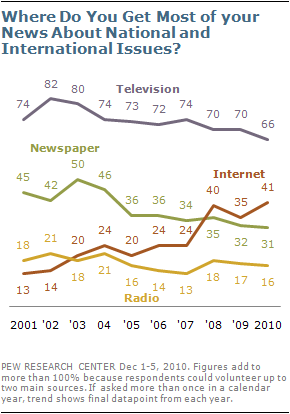 Earlier this year, the Pew Research Center released the findings of their latest national survey about Americans’ main source of national and international news. The survey was conducted in December 2010 and included 1,500 adults. The chart at right illustrates how the results of this survey have changed over time. Among the significant changes:
Earlier this year, the Pew Research Center released the findings of their latest national survey about Americans’ main source of national and international news. The survey was conducted in December 2010 and included 1,500 adults. The chart at right illustrates how the results of this survey have changed over time. Among the significant changes:
- From 2002 to 2010, television showed a 16% decline (from 82% to 66%)
- In 2010, for the first time, the internet has surpassed television as the main source of national and international news for people younger than age 30
- College graduates and college attendees (all ages) are about as likely to get most of their national and international news from the internet as television, but less than a third of those with only a high school education turn to the internet as a primary news source
- Those with household incomes of $75,000 or more are about as likely to get most of their news on the internet as from television, but approximately a third of those with household incomes under $30,000 select the internet as a primary news source
So What?
In less than 10 years the number of people who get most of their news online has grown from 13% to 41%. While the strong preference for the internet may not be surprising among those under 30 years of age, the older age groups are moving in a similar direction although at a slower speed:
- Under 30: internet has surpassed television as the main source of national and international in 2010
- Ages 30 to 49: the internet is on track to equal, or perhaps surpass, television as the main source of national and international news within the next few years
- Ages 50 to 64: the internet now rivals the newspaper (34% to 38%) as the main source of national and international news but ranks far behind television
- Ages 65 and better: the internet is the preference of only 14% as the main source of national and international news
Take a few minutes to think about your own experience over time.
- Which age group are you in? educational group? income group?
- From which source did you get most of your news in 2002? In 2010?
- How well do your answers about your current preferences fit with the description of your groups (age, education and income)?
What implications do these shifts in how people prefer to get news have for the local church? How has your congregation’s communication strategy shifted in the last decade?